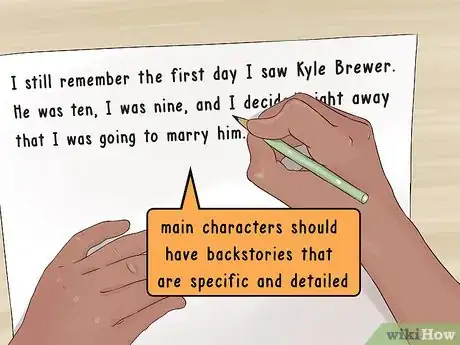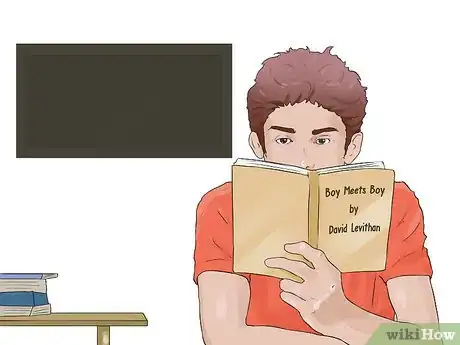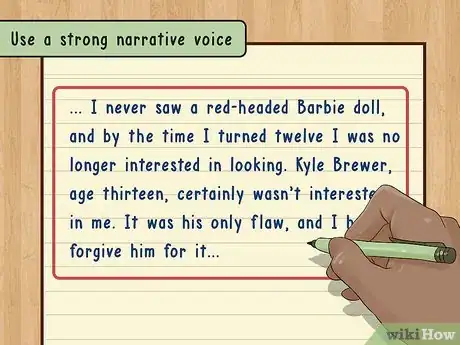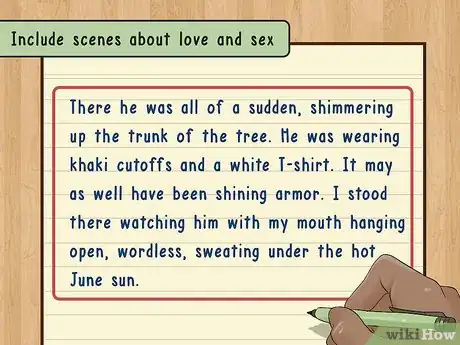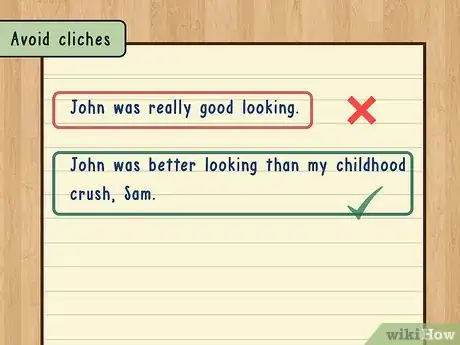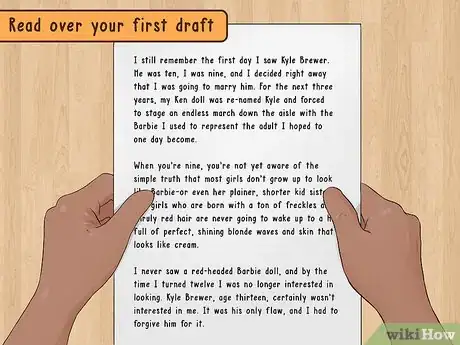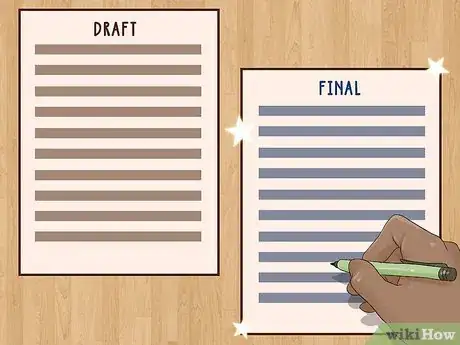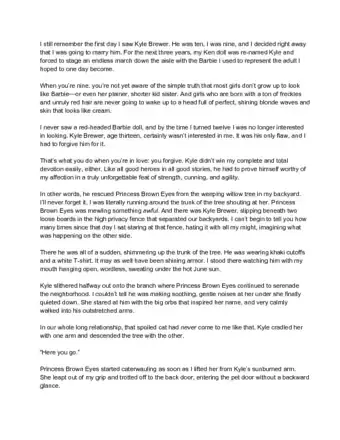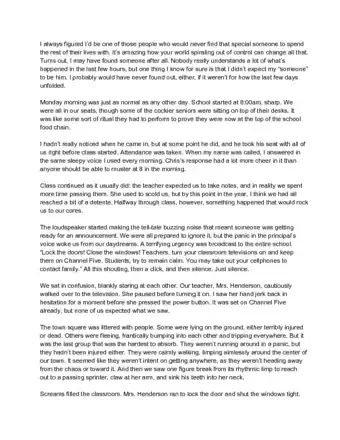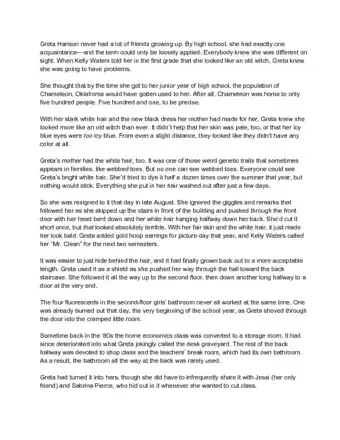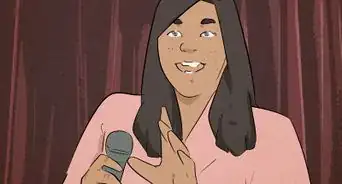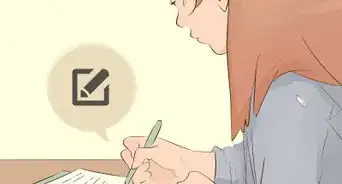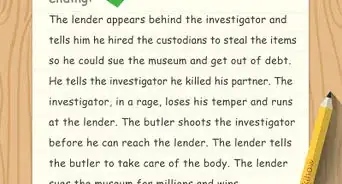X
This article was co-authored by wikiHow Staff. Our trained team of editors and researchers validate articles for accuracy and comprehensiveness. wikiHow's Content Management Team carefully monitors the work from our editorial staff to ensure that each article is backed by trusted research and meets our high quality standards.
This article has been viewed 58,209 times.
Learn more...
Want to write your own teen romance novel but you're worried it will get lost in the crowd? We can help you put a unique spin on your book so you'll have a better chance of standing out!
Steps
Part 1
Part 1 of 3:
Starting the Novel
-
1Come up with an original story idea. To get started on your teen romance novel, you first need to come up with a story idea that feels original and fresh. You may put an original spin on a story you have read before or a common storyline in teen romance novels. Remember your audience is teens so your story idea should contain elements that teens are interested in, such as young love, intense emotion, sexual awakening, and an aversion to authority.[1]
- For example, you may put a spin on the girl meets boy or boy meets girl storyline by having the boy/girl be an alien from another planet or have the girl/boy possess a superpower that tends to repel most boys/girls.
- You may also draw on your own life experiences to help you create an interesting story idea for your romance novel. Think about how you felt as a teenager and some of the situations or conflicts you got yourself into. You could then use your experiences to create a storyline for your novel.
-
2Create unique main characters. You should also start to create the main characters in your teen romance novel that feel unique. Your main character or characters should have backstories that are specific and detailed, as this will allow them to feel real and distinct. You should also allow your main characters to be flawed and make mistakes or bad choices. Having a perfect, safe main character will likely lead to a boring teen romance novel that may not find many readers.[2]
- For example, you may have a main character who realizes s/he can read minds, but struggles to make friends at his/her high school or get the attention of a girl/boy s/he likes. Though your main character has a certain power, s/he still has flaws and experiences failure.
Advertisement -
3Make a plot outline. Once you have a sense of your story and your main characters, you should sit down and create a plot outline. Creating a plot outline can help guide you once you sit down to write the novel and give you a sense of your story overall.
- Most teen romance novels follow a very similar plot outline: infatuation, flirtation, friendship, commitment, and finally, love. You may end your novel with a happily-ever-after, but most teen romance novels do not end on a forever note. In fact, your ending may be more open-ended or indicate that your characters may only be in love while they are young.
-
4Read examples of teen romance. To get a better sense of the genre, you may read several published teen romance novels. You may try to read a variety of teen romance novels, from the more popular to the more obscure, so you have a good sense of what is being written and published in the genre. You may read several examples, including:[3]
- The Perks of Being a Wallflower by Stephen Chbosky.
- Eleanor & Park by Rainbow Rowell.
- Boy Meets Boy by David Levithan.
- To All the Boys I’ve Loved Before by Jenny Han.
Advertisement
Part 2
Part 2 of 3:
Writing the Novel
-
1Write with your character’s goals in mind. When you sit down to write the novel, you should always consider your character’s goals and determine how they affect what happens in the story. Your main character should have specific goals or wants that s/he would like to achieve. Your protagonist’s goals will push the story forward and add drama to the events in the story.[4]
- You should then place obstacles in your main character’s way that s/he must overcome to achieve his/her goals and consequences if your main character fails to attain his/her goals. This will create conflict and tension in the story, which will keep your reader engaged.
- For example, maybe you have a main character who was born able to read minds and is entering his/her first year of high school. S/he may have goals like making friends and getting to know the cute girl or handsome boy in his/her art class. But s/he may have to overcome his/her insecurities about his/her special abilities and resist the urge to read his/her crush’s mind so s/he has a real chance at a relationship with him/her.
-
2Use a strong narrative voice. Your novel will be much stronger if you make sure there is a strong narrative voice throughout the story. You may use the first person voice of your main character to give the language in your story more character and specificity. Or you may use a third person voice that still feels unique and specific to the story. A strong narrative voice will keep your reader engaged and make your characters sound more distinct on the page.[5]
- You may ask yourself, How would my main character describe this scene? How would my main character describe another character? What kind of language would s/he use? These questions can help you get into the mindset of your main character and write from his/her narrative voice.
- For example, you may have your main character use slang that is common among teenagers to describe scenes and characters around him/her. S/he may say things like, “The girl was hot” or “I checked her Facebook profile and it said ‘single’.”
-
3Include scenes about love and sex. Teen romance novels are written with teens in mind and they should include discussions around a topic most teens are thinking about: sex. Though you may feel shy about discussing sex in your novel, including scenes about sex in your story can make it feel more relatable to your audience. Try to discuss sex in an open, honest way.[6]
- For example, you may have your main character discuss sex with other characters or consider having sex with another character. Make sure you include all the awkward moments of a first kiss, a first make out, and a first time. This will make the scenes feel more honest and believable to teens.
- Though you may want to include notes about safe sex, such as the use of condoms, you should not paint sex as a taboo, shameful thing. Keep an open mind about sex among young people and make sure your characters share that open mind as well.
-
4Avoid cliches. To ensure your teen romance novel feels original and unique, you should strive to avoid cliches. Cliches are phrases or descriptions that have become so familiar they have lost all meaning. The romance genre tends to be littered with cliches so you should do your best to have descriptions that feel specific and unique to your story, rather than phrases a reader may have heard before.[7]
- For example, you should avoid describing a character as “really good looking”, “sultry and sexy”, or “tall, dark, and handsome.” These descriptions have been used many times before and will not have much of an impact on readers.
- Instead, you should create descriptions that feel specific to your story’s narrative voice and your main character. Your main character may describe an attractive guy as “better looking than my childhood crush, Tristan” or a mean girl as “worse than my mother on a good day.” Keep your descriptions fresh and unique to your characters so they do not become cliche.
Advertisement
Part 3
Part 3 of 3:
Polishing the Novel
-
1Read over your first draft. Once you have finished the first draft of your teen romance novel, you should read it over from start to finish. You may make notes or underline sections as you read it over. Look out for sections that contain awkward sentences or cliche descriptions. Mark any sections that feel underdeveloped or any plot points that have not been fully explored.[8]
- You should also read the draft out loud so you can hear how the dialogue, descriptions, and characters sound on the page. You may mark any moments that do not flow well when reading out loud and underline them so you can revise them.
-
2Share the draft with teen readers. You should also try to share your first drafts with your core audience: teen readers. You may ask a teenaged friend or acquaintance to read over the draft and give you feedback on the story. Listen to what your teen reader has to say and use their feedback to improve your draft.[9]
- You may also discuss certain elements of your story with your teen reader. You may ask if your story feels unique or distinct, especially if your teen reader knows of other popular teen romance novels. You may also ask for advice on how to make your story feel more original.
-
3Revise the draft. Once you have received feedback on your novel and read it over several times, you may sit down and revise the draft. You may focus on certain sections that feel underdeveloped or sentences that seem awkward or unclear.[10]
- You may also think about how you can improve upon your story and make it more original. If you notice certain elements of your story seem too familiar or cliche, you may adjust them and revise them until they feel more unique.
Advertisement
Community Q&A
-
QuestionHow do I write a romance novel if I have never touched the subject?
 Community AnswerStart reading romance books. They'll give you a good insight on the subject. Otherwise, you are working with the same structure as any other fiction.
Community AnswerStart reading romance books. They'll give you a good insight on the subject. Otherwise, you are working with the same structure as any other fiction. -
QuestionI have a real life teen love story but I am struggling on how to write a reason for them to have some time so that they can fall in love because both the main characters are very ambitious.
 Community AnswerYou could have one character that needs tutoring so the other character helps or they could be paired together for a project at school or working somewhere together after school.
Community AnswerYou could have one character that needs tutoring so the other character helps or they could be paired together for a project at school or working somewhere together after school. -
QuestionHow do I write a romance novel for teens if my love life is books?
 Tom De BackerTop AnswererMaybe an actual book comes to life, or a book has lost all its words? Perhaps one morning all books are gone from the face of the earth and you have to recover them all. Or two people bond over their love of books. Or two people really truly fall in love, except one loves books and the other hates them, causing a conflict to be resolved.
Tom De BackerTop AnswererMaybe an actual book comes to life, or a book has lost all its words? Perhaps one morning all books are gone from the face of the earth and you have to recover them all. Or two people bond over their love of books. Or two people really truly fall in love, except one loves books and the other hates them, causing a conflict to be resolved.
Advertisement
References
- ↑ http://thewritepractice.com/20-romance-story-ideas/
- ↑ http://www.creative-writing-now.com/how-to-write-romance.html
- ↑ https://www.commonsensemedia.org/lists/teen-romance-novels-completely-vampire-free
- ↑ http://www.writersdigest.com/whats-new/how-to-write-a-romance-novel-the-keys-to-conflict
- ↑ http://diymfa.com/community/redefining-teen-romance-writing-sex-love-emotions
- ↑ http://diymfa.com/community/redefining-teen-romance-writing-sex-love-emotions
- ↑ http://www.creative-writing-now.com/how-to-write-romance.html
- ↑ http://thewritelife.com/self-editing-basics/
- ↑ http://thewritelife.com/self-editing-basics/
About This Article
Advertisement

